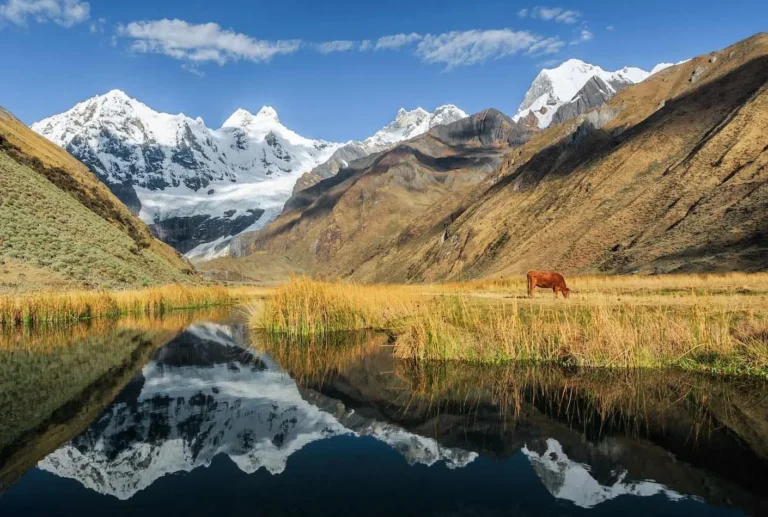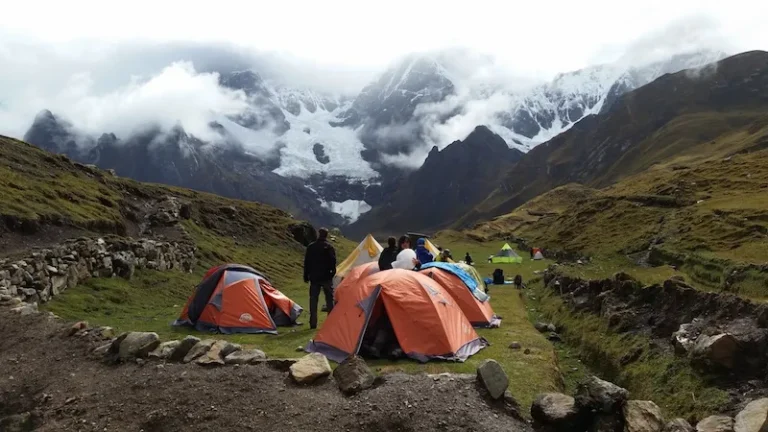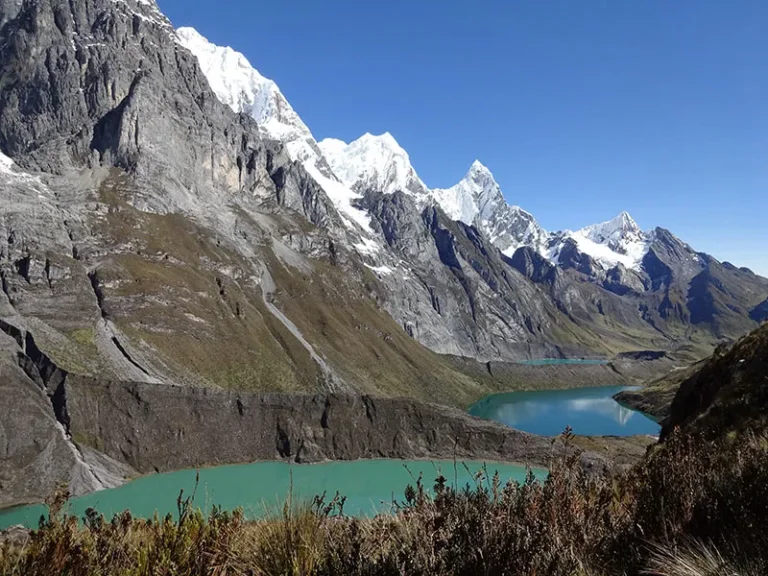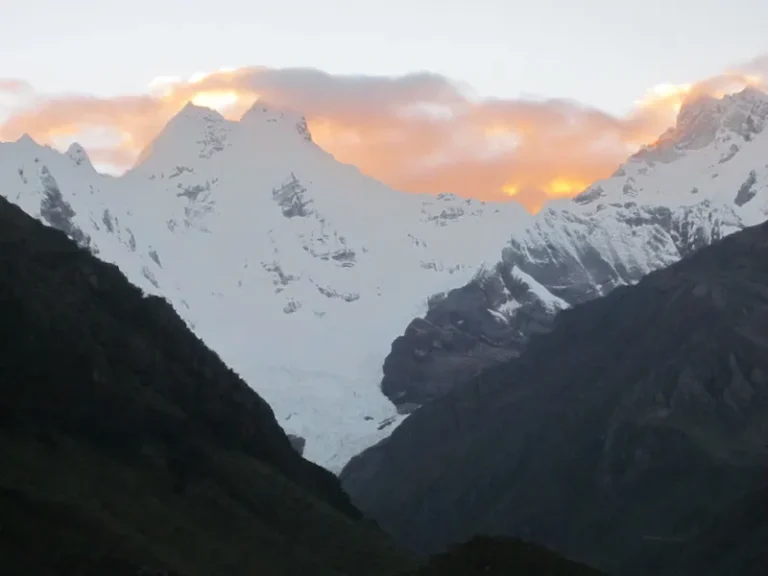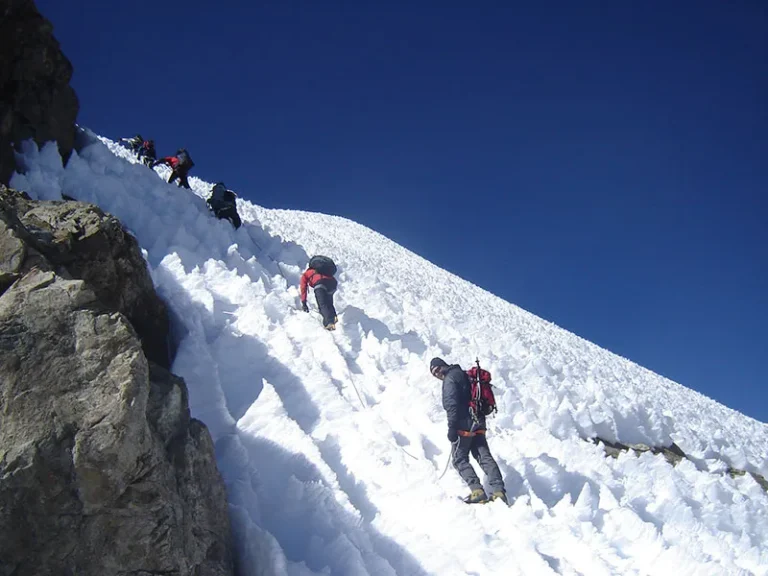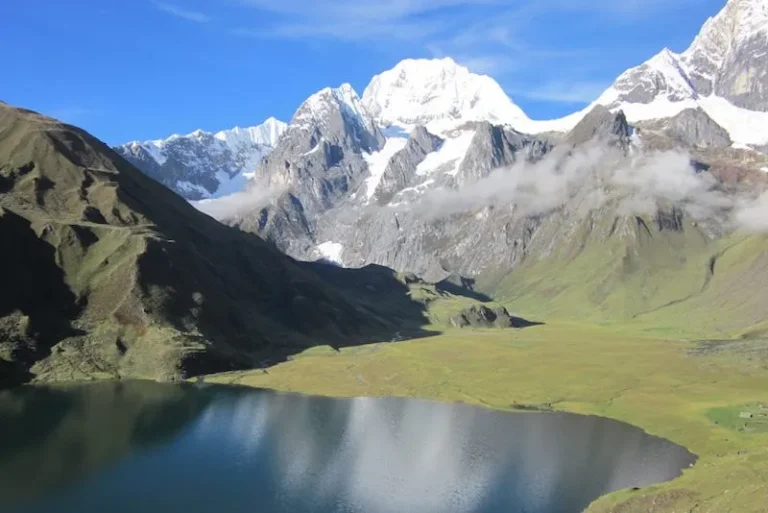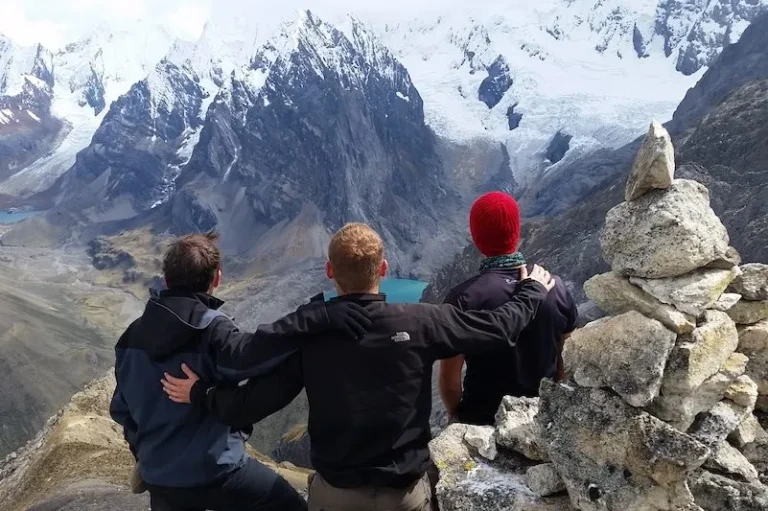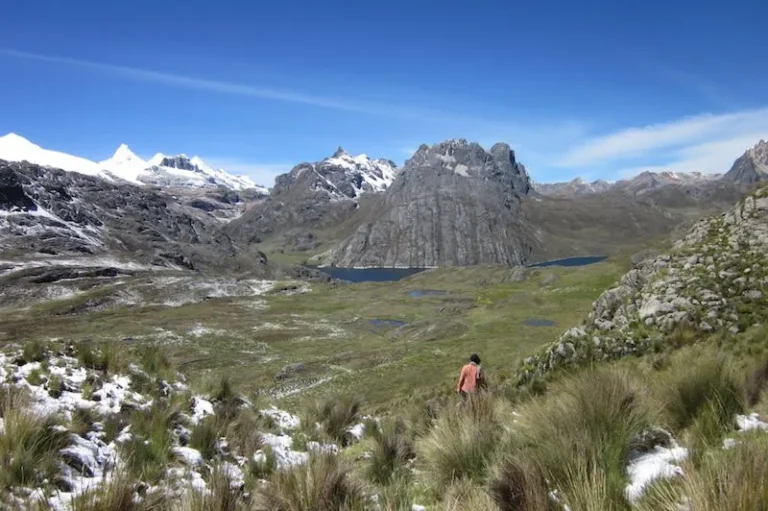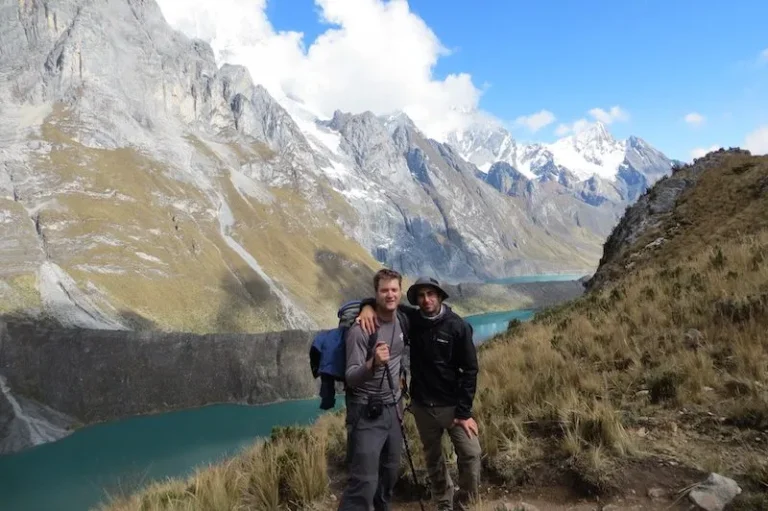Highlights:
- Acclimatization with dayhikes to Laguna Wilcacocha and Laguna 69
- Trekking around the Cordillera Huayhuash – one of the most beautiful treks in the world
- Untouched mountain landscapes, intensely glaciated
- Dreamlike campsites you will remember forever
- Crossing 8 high altitude passes
- Optional sidetrip to famous Paso San Antonio (4990m)
- Views to Yerupaja Grande (6634 m)
- Optional climbs: Nevado Diablo Mudo (5223 m) and Cerro Berlin (5094 m)
Character
For optimal acclimatization we start our program with day hikes to the Laguna Wilcacocha and Laguna 69. The big circuit of the Cordillera Huayhuash lasts 11 days, almost always moves at altitudes over 4000m and overcomes at 170 km distance 8 passes between 4300 and 5000m. You can optionally climb Diablo Mudo (5223 m) and Cerro Berlin (5094 m).
Requirements
Surefootedness, a head for heights, a good physical condition, team spirit and willingness to leave your comfort zone. You should have hiked in the mountains already. In preparation for this trip, we recommend conditioning and extensive walks. There are many high passes, some over 5’000 m. The hiking times per day are between 4 to 9 hours and can vary depending on the condition of the group and weather. The height differences to be overcome in the climb are a maximum of 900 m, in the descent maximum 1150 m per day.
Best Season
The best trekking season in the Andes is from April to October, with rainy season in between. It is usually sunny and warm during this time. Due to the altitude, the nights can be quite cold (to minus 5 ° C).
Extra Time
Individual connection programs with Machu Picchu, Colca Canyon and much more are possible. Contact us!
What is included in this tour?
Items that are included in the cost of tour price.
- Transports according to itinerary
- Bus tickets Lima – Huaraz – Lima
- Accommodation in Lima and Huaraz
- Acclimatization hikes according to itinerary
- Entrance fees to Huascaran National Park
- Entrance fees to Cordillera Huayhuash
- Qualified and experienced guide (Spanish/English)
- Cook and assistant
- Donkeys and donkey driver
- Emergency horse
- All meals during the trek
- Good quality high mountain tent (2 or 3 person)
- Dining tent, table and chairs
- Cooking utensils
- First aid kit and oxygen
What is included in this tour?
Items that are not included in the cost of tour price.
- Meals in Lima and Huaraz
- Alcoholic drinks
- Personal equipment
- Medical care or insurance
- Emergency rescue or evacuation
- Additional expenses as a result of leaving the trek early
- Travel insurance
- Flights
- Tips (optional)
Day 1: Acclimatization hike to Laguna Wilcacocha
We pick you up at the hotel and drive south to the Santa Cruz bridge. Here begins our hike through the picturesque highlands and small Andean villages. We slowly ascend to the Laguna Wilcacocha (3’700m), where we enjoy a 360° panoramic view of the whole Cordillera Blanca. We walk the same way back to the bridge, where our transport waits and brings us back to Huaraz.
- Driving time: 20 minutes
- Hiking time: 4 hours
- Meals included: Breakfast, packed lunch
- Accommodation: Hotel
Day 2: Acclimatization hike to Laguna 69
A long day: We pick you up at 5 am and drive for about 3 hours north to the Huascaran National Park. Past the famous Llanganuco lakes, we soon reach the starting point of today’s hike to Laguna 69 (4’650m), one of the most famous and popular lakes in the Cordillera Blanca. The Laguna is located directly under the huge ice walls of Chacraraju mountain, one of the most beautiful but also difficult 6000m peaks of the Cordillera Blanca. Our trail goes through rustic mountain forests, when we turn around, the gigantic Huascaran rises behind us. Some steep serpentines later the edge of the lake is suddenly reached. We enjoy the unique view and have enough time for lunch and some rest before we head back to Huaraz.
- Driving time: 6 hours
- Hiking time: 5-6 hours
- Meals included: Breakfast, packed lunch
- Accommodation: Hotel
Day 3: Drive to Cordillera Huayhuash
Our trekking adventure begins. You are picked up from your hotel and we head south of Huaraz crossing the villages of Chiquian and Llamac. During our drive we pass traditional Andean towns with typical Quechua homes and rich farm land. After 6.5 hours of driving we arrive to our first campsite Matacancha (4150m). Before dinner you have some time to explore the area around the campsite and get ready for the next day.
You are picked up in your hotel and we drive north following the course of the Rio Santa that divides the Cordillera Blanca in the east and the Cordillera Negra in the west. We pass traditional Andean towns and enjoy the magnificent view of the high peaks of the Cordillera Blanca range including Huascaran (6768m), Peru’s highest mountain. As we enter the Huascaran National Park, we continue our drive up this beautiful valley to reach Cebollapampa (3900m) where we start the hike up to Pisco Base Camp. This hike will take about 3 to 4 hours of steep ascending while we walk at a steady pace until we reach the Pisco base camp (4600m). We spend the night close to the Refugio Pisco Lodge.
- Driving time: 6.5 hours
- Meals included: Breakfast, lunch, tea time, dinner
- Accommodation: Tent
Day 4: Matacancha - Cacananpunta Pass - Laguna Mitucocha
Today we start hiking early and we reach Cacananpunta Pass (4700m) after 2.5 hours. We hike down to the beautiful campsite at Laguna Mitucocha (4’300m).
- Hiking time: 5 hours
- Meals included: Breakfast, lunch, tea time, dinner
- Accommodation: Tent
Day 5: Mitucocha - Punta Carhuac - Laguna Carhuacocha
Leisurely ascent to the 4’650 m high pass Punta Carhuac and descent to Laguna Carhuacocha (4200 m), one of the most beautiful campsites of the trek. When the wind is calm, the peaks of Jirishanca and Yerupajá Grande and Chico are reflected in the calm waters. Indigenous people live by the lake and with their permission we may have the opportunity to catch fresh trout for dinner.
- Hiking time: 4 hours
- Meals included: Breakfast, lunch, tea time, dinner
- Accommodation: Tent
Day 6: Carhuacocha - Siula Pass - Huayhuash
This route takes you close to the most bizarre peaks and glaciers of the Cordillera Huayhuash and is the most scenic stage of the trek. From the western shore of the Carhuacocha lake, a gentle ascent to Lake Siula (4290 m), past the ice break of the glacier that descends from the Nevado Sarapo (6143 m) to the next lake (4650 m) and finally Siula pass (4950 m), a fantastic outlook with overwhelming summit panorama. We descent to the next campsite called Huayhuash.
- Hiking time: 8 hours
- Meals included: Breakfast, lunch, tea time, dinner
- Accommodation: Tent
Day 7: Huayhuash – Portachuelo Pass – Laguna Viconga
The ascent to Portachuelo Pass (4750 m) is again dominated by magnificent mountain panoramas, this time on the ice-covered peaks of the southern Cordillera Huayhuash. Descent to the largest lake and the southernmost point of the trek, Laguna Viconga (4400 m). Here we have the opportunity to relax and swim in the hot springs right at the campsite.
- Hiking time: 7 hours
- Meals included: Breakfast, lunch, tea time, dinner
- Accommodation: Tent
Day 8: Laguna Viconga – Punta Cuyoc – Sidetrip to San Antonio Pass - Huanacpatay
Today we cross the highest pass of the tour, the 5020 m high Punta Cuyoc. The view is terrific – east to the Cordillera Raura with the huge plateau glacier, to the Nevados Puscanturpa just above the pass and – now from the south – to the highest peaks of the Cordillera Huayhuash, Sarapo, Siula and Yerupajá. Partly steep descent to Quebrada Huanacpatay to the camp (4350 m). Optional: Sidetrip to the famous San Antonio Viewpoint at 4990m, probably one of the most beautiful views in the Huayhuash range.
- Hiking time: 6-9 hours
- Meals included: Breakfast, lunch, tea time, dinner
- Accommodation: Tent
Day 10: Huanacpatay – Huayllapa – Huatiac
Today we descend along a beautiful waterfall into a green picturesque valley and hike to the village of Huayllapa (3600m), where they grow potatoes, wheat and lupines. Then we hike up 4 hours to reach our next campsite Huatiac (4’290m) with beautiful views of the mountains around us.
- Hiking time: 9 hours
- Meals included: Breakfast, lunch, tea time, dinner
- Accommodation: Tent
Day 11: Punta Tapush - Cashpapampa
Partly steep and difficult ascent, the last bit under the rocks of the glaciated, 5427 m high Raju Collota massif to Punta Tapush (4800 m). Again magnificent views, even on the slightly recessed Nevado Diablo Mudo (5223 m), tomorrow’s destination for ambitious and fit climbers. Short descent from the pass north to the Laguna Susococha (4600 m) and a little further to the camp at Cashpapampa (4500 m).
- Hiking time: 6 hours
- Meals included: Breakfast, lunch, tea time, dinner
- Accommodation: Tent
Day 12: Diablo Mudo Climb – Laguna Jahuacocha
The climbers with destination Diablo Mudo (5223 m) have a very long day ahead. We leave at 4am and walk steady uphill on a path for 1.5 hours. Then we have a steep ascent for about 2 hours until we reach the ridge of Diablo Mudo. We follow the ridge for about 40 minutes and then access the glacier via some loose scree. We put on crampons and rope up, then climb steadily up the glacier. Sometimes the guides will cut steps, but the going is not difficult and we should reach the summit after 3 hours on the ice. The descent is via a different route; we descend to the Huacrish Valley. The first section is on ice, followed by 40 minutes of descent on rock then scree. Then it gets significantly easier as we join a path through the meadows of the Quebrada Huacrish valley. We join the main path and proceed to hike down the entire valley to its confluence with the Quebrada Jahuacocha valley and descend on zig-zags to our picturesque camp at the head of the beautiful Laguna Jahuacocha (4050m).
Trekking without Diablo Mudo ascent: short descent from Cashpapampa to Quebrada Angocancha (4350 m) and ascent to Punta Llaucha (4850 m), from which you can still enjoy an impressive view. Steep descent in a northeasterly direction to Quebrada Huacrish, which leads directly to Laguna Jahuacocha (4050 m). Tent camp on the lakeshore, overlooked by the Nevados Rondoy, Jirishanca and Yerupajá.
- Hiking time: 11 hours
- Meals included: Breakfast, lunch, tea time, dinner
- Accommodation: Tent
Day 13: Rest day at Laguna Jahuacocha or climb Cerro Berlin
We stay at Jahuacocha for some rest and relaxation and maybe a touch of trout fishing. You may take an optional day hike to Laguna Solteracocha, a moraine-enclosed glacial lake beyond Jahuacocha, and then further towards Punta Sambuya pass (4750m) at the base of Nevado Rondoy for some truly awesome close-up views of Yerupaja, Jirishinka and Rondoy. Or if you want a more demanding hike, we can climb up Cerro Berlin peak (5’094m) for views over the whole Huayhuash range.
- Meals included: Breakfast, lunch, tea time, dinner
- Accommodation: Tent
Day 14: Jahuacocha - Llamac - Huaraz
Last trekking day: After descending for an hour, we start our gradual climb to the final pass Llamac (4300m), from where we have our final views of the Huayhuash range. Then it is a long descent back to the Llamac valley and the village of Llamac. From there we drive back to Huaraz.
- Hiking time: 5 hours
- Driving time: 4 hours
- Meals included: Breakfast, lunch
- Accommodation: Hotel

Climbing Diablo Mudo

Huayhuash trek
Camping
During the trek, you spend the night in two-person tents. The selection of camp sites depends on the reachable water points and takes into account – as far as possible – scenic spots. In the Cordillera Huayhuash there are countless dream camps on highland lakes at the feet of snow-capped peaks.
Hotels
In Lima and Huaraz, you are accommodated in a double room in good middle class hotels. A single room is possible for a surcharge.
Meals
During the trek we pay attention to a healthy and high-calorie diet. Breakfast and dinner are cooked warm. For lunch, a box lunch is served. We can prepare vegetarian dishes on request.
Transport
For the route Lima-Huaraz-Lima we work together with the bus company Oltursa, which is a public bus of the highest category. The rest of the transports take place in minivans or comfortable 4×4 off-road vehicles, depending on the group size. On request and not included in the price, we can also organize a private transport for the route Lima-Huaraz-Lima or a flight (only in the morning).
Luggage
Donkeys carry your luggage during the trek, you only carry your daypack. On the day of the Diablo Mudo climb you need to carry your own personal gear and lunch box.
Packing list
Our recommendation
- Backpack
- Head torch (with spare batteries)
- Sandals
- Well-worn in hiking boots
- Down jacket
- Rain jacket or poncho
- Fleece or warm pullover
- Comfortable clothes (quick dry, merino)
- Trekking trousers
- Long thermal underwear (merino)
- Warm socks
- Cap, gloves
- Sunhat, sunglasses, sunscreen (min factor 40)
- Hiking poles
- Sleeping bag -10° comfort
- Toilet paper and wet wipes
- Personal medication travel kit
- Water bottle and water purification pills
- Extra Snacks (your favorite chocolate)
- Extra money
Extra things if you climb Diablo Mudo:
- Waterproof jacket and trousers (Gore-Tex)
- Very warm and waterproof gloves (Gore-Tex)
- Mountain goggles
- Mountain boots
- Crampons
- Ice Axe
- Helmet
- Harness
- Carabiner
Frequenly asked questions
Do I need an insurance for the trip?
A private travel cancellation insurance is recommended. Absolutely recommended is a foreign health insurance. For a longer trip a baggage insurance is recommended.
What are the visa and entry requirements?
The requirements depend on your country of origin, please contact us and we help you with this.
Which currency do I need for this trip?
The currency in Peru is the Sol ($ 1 = approx. 3.30 Soles). The US dollar has become the second most important means of payment in Peru. In many places, especially in tourist areas, you can pay directly with him. You can therefore carry most of your cash in US $. However, the euro has now established itself in the bureaux de change. Foreign currency in Peru can be exchanged at banks or so-called Casas de Cambio (the bureaux de change). In Peru, it is common and legal to exchange US dollars even with authorized money changers on the street. This possibility is especially perceived by the Peruvians themselves. The exchange rates on the road hardly differ from those of the banks. Credit cards are only accepted in better restaurants or shops in larger cities. As a means of payment they are only recommended for the purchase of higher value souvenirs or for the purchase of airline tickets or for the payment in very good hotels. At most ATMs in Peru, you can withdraw money in addition to credit cards (VISA and Master Card) with your debit card (Maestro Symbol!). An important tip: always make sure to have enough small change with you. It often happens that there is no change. Slightly torn dollar bills in banks and change offices are generally rejected.
How do I prevent altitude sickness?
Some basic rules:
- Do not climb too fast, allow several days for a gradual acclimatization
- It can be very useful to take a break at around 3,000 m for a few days
- Drink more than enough water
- Do not drink any alcohol
- Cure infections and other diseases beforehand
- Do not take sleeping pills
- Carbohydrate-containing foods, as they consume less oxygen than fats and proteins
- Drink coca tea or chew coca leaves
REVIEWS
There are no reviews yet. Be the first one to write one.

